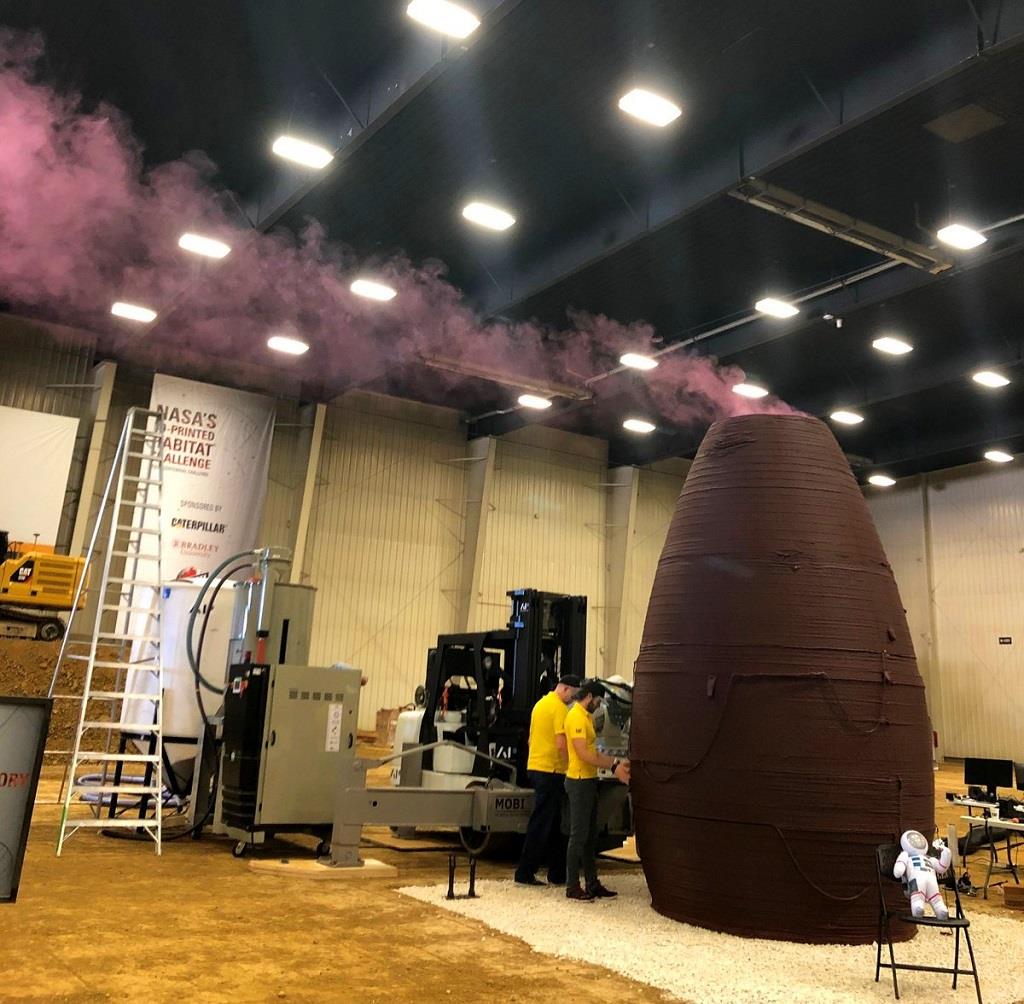![AI. SpaceFactory’s 3D printed structure undergoes smoke testing [Image: NASA Centennial Challenge]](https://fabbaloo.com/wp-content/uploads/2020/05/aispacefactory_img_5eb0980fdb9ef.jpg)
NASA’s four-year 3D-Printed Habitat Challenge has announced its top prizes.
Introduced in 2015, the challenge was conducted in three phases:
-
The Design Competition, completed in 2015
-
The Structural Member Competition, completed in 2017
-
The On-Site Habitat Competition, just completed
Each phase offered multiple levels of activity, and prize incentives. Overall, more than 60 teams fought for the crown and NASA and its partners and sponsors awarded more than $2 million for the efforts.
Phase three began in 2017 and was, appropriately, pretty complex, comprised of five levels. Narrowing down the field of participants, five teams were awarded funds to further their work. In the recent virtual construction level, three teams shared a $100,000 prize for their efforts.
The very final phase, though, was a tight race that came down to a one-on-one, head-to-head competition.
Four days, 30 hours of 3D printing, and 1:3 scale versions of the structures showcased the best that AI. SpaceFactory and Pennsylvania State University of College Park could bring to the table.
All 3D printing was done live in front of the judging panel, created in 10-hour increments. The printed structures were then thoroughly tested and evaluated, checked out for material mix, leakage, durability, and strength.
Tests included smoke, impact, and crushing to see how the structures might stand up to the harsh environments encountered on the moon and Mars.
Our two 3D-printed structures have undergone the first of 3 tests today: a smoke test to check the habitat's ability to hold a seal. @penn_state is the gray; @AISpaceFactory is the dark red. Upcoming tests are impact and crushing! More at https://t.co/GUvssn05Ia pic.twitter.com/bSywy0VbO0
— Centennial Challenge (@NASAPrize) May 4, 2019
We're simulating meteor strikes on the Moon and Mars by chucking mini cannonballs at 3D-Printed structures meant for deep space exploration. Will they survive? ¯\_(ツ)_/¯ Watch and find out: https://t.co/uttHaWRufl
— NASA360 (@NASA360) May 4, 2019
Crushed it! @penn_state’s 3D-printed structure was a smashing success during the final test in the 3D-Printed Habitat Challenge. pic.twitter.com/UCuOqz9JW5
— Centennial Challenge (@NASAPrize) May 4, 2019
At the end of the day(s), it was AI. SpaceFactory of New York that won the final round, awarded the top $500,000 prize.
Pennsylvania State University of College Park took a stellar second place, claiming a $200,000 prize.
“It is an impressive achievement for these two teams to demonstrate this disruptive and terrific 3D-printing technology at such a large scale. By teaming up with NASA and Caterpillar, we are proud to bring these teams together in an environment where they can innovate, create and challenge our vision of what’s possible. Congratulations to both teams for their accomplishments,” said Lex Akers, dean of Bradley’s Caterpillar College of Engineering and Technology.
The final two designs were certainly put through their paces. The final four days were quite eventful, and NASA shared the goings-on during the May 1-4 face-off at Caterpillar’s Edwards Demonstration & Learning Center in Edwards, Illinois.
A livestream, with videos now available on-demand, captured the last days of this years-in-the-making habitat competition, including the 3D printing, the testing, and the awarding of the final prizes.
“The final milestone of this competition is a culmination of extremely hard work by bright, inventive minds who are helping us advance the technologies we need for a sustainable human presence on the Moon, and then on Mars,” said Monsi Roman, program manager for NASA’s Centennial Challenges. “We celebrate their vision, dedication and innovation in developing concepts that will not only further NASA’s deep-space goals, but also provide viable housing solutions right here on Earth.”
![AI. SpaceFactory of New York wins the final round of NASA's 3D-Printed Habitat Challenge, held at Caterpillar's Edwards Demonstration & Learning Center in Edwards, Illinois. [Image: NASA/Emmett Given]](https://fabbaloo.com/wp-content/uploads/2020/05/aispacefactorywiners_img_5eb09810652d8.jpg)
We’ve enjoyed watching this competition since 2015, and now that it’s over there’s still a lot to think about.
Is 3D printing really an option for building a habitat on the moon, Mars, or elsewhere off-Earth? Obviously there’s quite a lot that has to happen outside of additive manufacturing before extraterrestrial living quarters become the primary focus, but now we know that well-qualified teams are actively thinking about what all will actually be needed.
What does this mean for 3D printing in construction? Will these lessons be applied closer to home? How?
What else will come of this challenge, for NASA, for 3D printing, for construction? That remains to be seen. For now, though, our hearty congratulations to the final two teams for their performance, and to the winners at AI. SpaceFactory!
Via NASA


1 comment
Comments are closed.